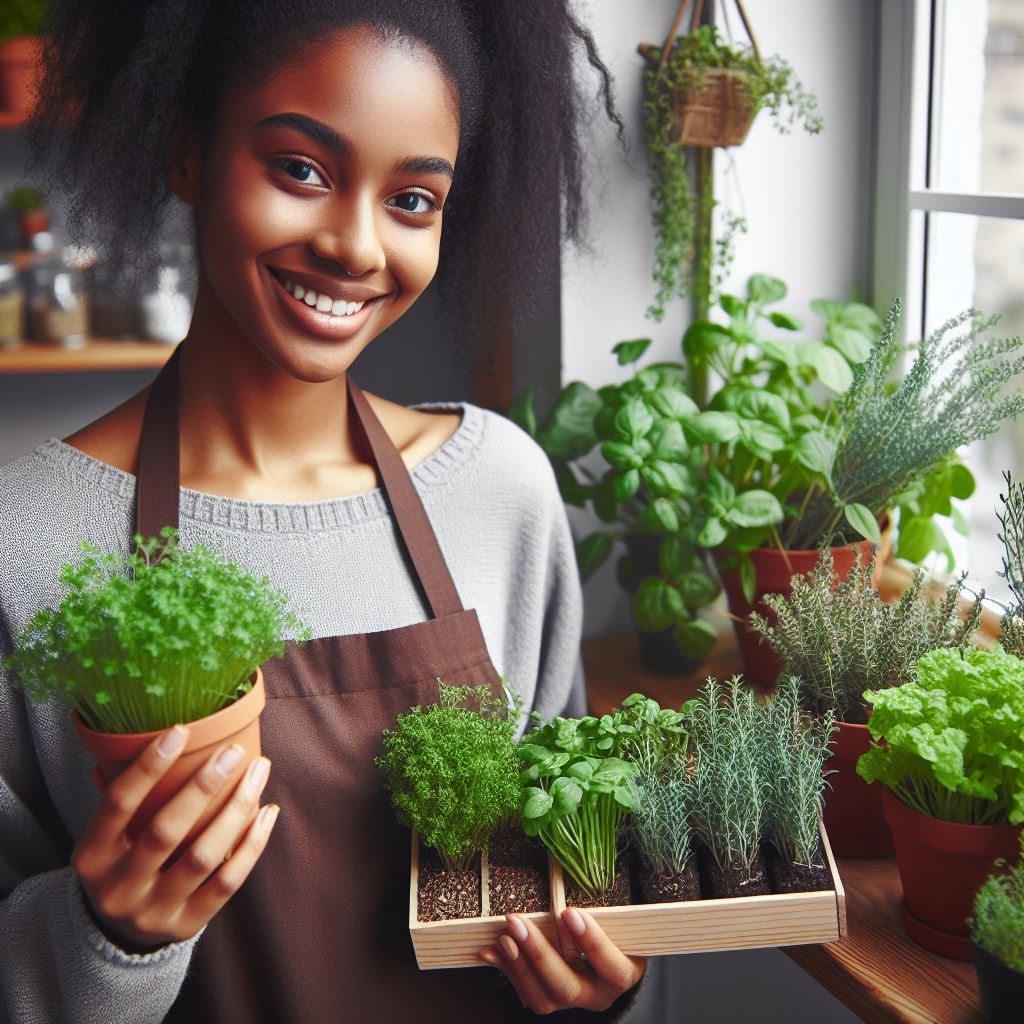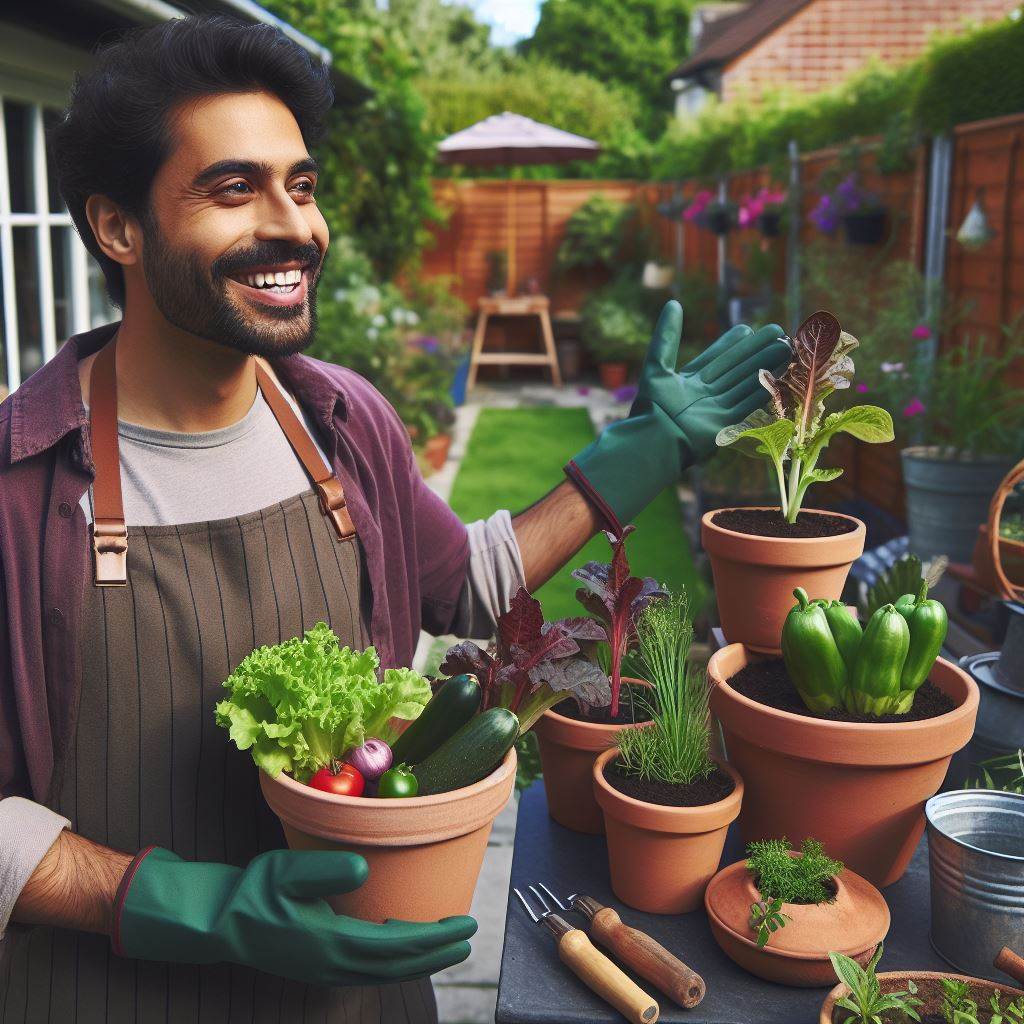Introduction to window gardening
Increasing popularity of window gardening
Window gardening has become increasingly popular in recent years, as more people are realizing the benefits and convenience of growing herbs indoors.
Not only does it add a touch of greenery to urban spaces, but it also allows individuals to have fresh herbs right at their fingertips.
Benefits and convenience of growing herbs indoors
The advantages of window gardening are numerous.
Firstly, it requires minimal space, making it perfect for those living in small apartments or houses with limited outdoor areas.
Additionally, growing herbs in a windowsill allows for easy access and maintenance, as they are within arm’s reach for watering and harvesting.
Introduce the topic of easy herbs for window gardening success
Now, let’s delve into the topic of easy herbs for window gardening success.
These herbs have been selected based on their ability to thrive in indoor conditions and their versatility in culinary applications.
- Basil – Known for its aromatic leaves, basil is a popular herb that adds flavor to a variety of dishes, including pasta, salads, and sauces. It requires ample sunlight and well-drained soil.
- Mint – This herb not only offers a refreshing taste, but it also acts as a natural pest deterrent. Mint can be used in teas, cocktails, and desserts, and it grows well in partial shade.
- Chives – Chives are valued for their mild onion flavor and are often used to garnish salads, soups, and baked potatoes. They prefer cool temperatures and thrive in bright, indirect light.
- Parsley – Widely recognized as a versatile herb, parsley is essential in many Mediterranean and Middle Eastern cuisines. It requires moderate sunlight and regular watering.
- Thyme – With its earthy flavors, thyme is a favorite herb for seasoning meats, soups, and stews. It prefers well-drained soil and can tolerate drier conditions.
Therefore, window gardening offers a convenient and rewarding way to grow herbs indoors.
By choosing easy-to-grow herbs like basil, mint, chives, parsley, and thyme, individuals can enjoy the benefits of fresh herbs all year round.
Choosing the Right Herbs for Window Gardening
When it comes to window gardening success, selecting the right herbs is crucial for thriving indoor plants.
This section highlights the importance of choosing herbs that are suitable for indoor growing and discusses key factors to consider, such as sunlight requirements, space limitations, and maintenance needs.
Below are some recommendations for herbs that thrive in window gardens:
Sun-loving Herbs
- Basil: This herb loves sunlight and requires at least 6 hours of direct light each day.
- Thyme: Known for its aromatic leaves, thyme prefers a sunny location to grow and thrive.
- Rosemary: This herb needs plenty of sunlight and can tolerate dry conditions.
- Oregano: Oregano enjoys full sun exposure and well-drained soil.
Shade-tolerant Herbs
- Parsley: Parsley can grow in partly shaded areas but thrives best in bright, indirect light.
- Mint: Mint can tolerate some shade, making it a great option for window gardens with limited sunlight.
- Chives: These versatile herbs prefer partial shade and can be grown in small pots or containers.
- Cilantro: Cilantro can handle moderate shade but appreciates some sunlight for healthy growth.
Compact Herbs for Limited Space
- Chervil: This delicate herb is perfect for small windowsills and has a mild anise-like flavor.
- Microgreens: These tiny and nutrient-packed herbs can be grown in small trays or containers.
- Dwarf Sage: With its compact size, dwarf sage fits well in small window gardens.
- Miniature Varieties: Look for miniature versions of herbs like thyme or basil for limited space.
Low-maintenance Herbs
- Succulents: These water-storing plants, like aloe vera or jade, require very little attention.
- Chamomile: Chamomile is a hardy herb that requires minimal care, making it perfect for beginner gardeners.
- Lemon Balm: This herb is easy to grow and doesn’t demand much maintenance or attention.
- Marjoram: Marjoram is a low-maintenance herb that thrives in a variety of growing conditions.
Remember, when choosing herbs for window gardening, consider your specific sunlight conditions, available space, and the amount of time you can dedicate to maintenance.
By selecting suitable herbs, you can create a beautiful and thriving window garden that brings fresh flavors and aromatic scents into your home.
Read: Grow Herbs on Your Porch: Simple Techniques
Transform Your Agribusiness
Unlock your farm's potential with expert advice tailored to your needs. Get actionable steps that drive real results.
Get Started3 Popular Easy Herbs for Window Gardening
Window gardening is a great way to bring fresh herbs into your home and add flavor to your dishes.
If you are a beginner looking to start your own window garden, here are three popular and easy herbs to get you started:
Basil
Basil is a versatile herb that is commonly used in Italian dishes.
It is beginner-friendly and grows well in small pots on a sunny windowsill.
- Characteristics: Basil has aromatic leaves and grows as a bushy plant with green or purple leaves.
- Growth Habits: It requires well-drained soil and regular watering to keep the soil moist. It thrives in warm climates.
- Caring: Trim the basil regularly to encourage bushier growth. Pinch off the flowers to prevent the plant from going to seed.
- Harvesting: Harvest the leaves from the top down by pinching off individual leaves or cutting whole stems.
- Utilizing: Use basil in pasta sauces, salads, pesto, and even in drinks like infused water or cocktails.
Mint
Mint is a refreshing and aromatic herb that is perfect for window gardens.
It is known for its easy growth and vast variety of flavors.
- Characteristics: Mint has square stems with small, serrated leaves. It grows rapidly and can become invasive if not contained.
- Growth Habits: It prefers partial shade and moist soil. Mint can be grown from seeds or cuttings.
- Caring: Regularly water the mint plants and keep an eye out for any signs of pests. Divide the plant every few years to control its growth.
- Harvesting: Pinch off the leaves as needed, leaving some on the plant for continued growth.
- Utilizing: Use mint leaves in cocktails, teas, desserts, salads, and as a garnish for various dishes.
Oregano
Oregano is a versatile herb that adds a robust flavor to a wide range of dishes.
It is easy to grow and can thrive in small containers.
- Characteristics: Oregano has small, oval-shaped leaves with a strong aroma. It produces small clusters of white or pink flowers.
- Growth Habits: It prefers well-drained soil and full sun. Oregano can be grown from seeds or cuttings.
- Caring: Water oregano plants moderately, allowing the soil to dry out between waterings. Trim the plant regularly to maintain its shape and encourage new growth.
- Harvesting: Harvest the leaves just before the flowers bloom for the best flavor. Cut stems or pinch off leaves as needed.
- Utilizing: Use oregano in Italian dishes, pizza, roasted vegetables, marinades, and dressings.
By starting with these beginner-friendly herbs, you can embark on your window gardening journey with confidence.
Remember to provide them with the right conditions, care for them diligently, and enjoy the bountiful harvests in your cooking!
Read: Urban Veggie Gardens: Small Spaces, Big Yields

Setting up a window herb garden
Choosing the right containers for window gardening
- Opt for containers with good drainage, such as pots with drainage holes or self-watering containers.
- Consider the size of the container, ensuring it can accommodate the herb’s root system.
- Select containers that match the aesthetic of your window and complement the herbs.
Soil selection and the importance of proper drainage
- Use well-draining soil that is specifically formulated for container gardening.
- Avoid heavy or compacted soil, as it can lead to waterlogging and root rot.
- Mix in organic matter like compost or coco coir to improve the soil’s fertility and drainage.
Arranging and positioning herbs for optimal growth and aesthetic appeal
- Group herbs with similar sunlight and watering requirements together.
- Place taller herbs at the back of the container or window box, and shorter herbs towards the front.
- Ensure that each herb has enough space for its roots to spread and receive adequate sunlight.
Watering, fertilizing, and maintaining plant health in a window garden environment
- Regularly check the moisture level of the soil and water accordingly, keeping in mind that containers may dry out quicker than garden beds.
- Water the herbs at their base to prevent waterlogging and minimize the risk of fungal diseases.
- Apply a balanced liquid fertilizer every 2-4 weeks to provide essential nutrients for healthy growth.
- Monitor for pests and diseases, and take necessary measures like using organic pest control methods or pruning affected leaves.
- Regularly trim herbs to promote bushier growth and prevent them from becoming leggy.
- Consider providing additional support, such as stakes or trellises, for climbing herbs like mint or thyme.
By following these tips, you can set up and maintain a thriving window herb garden that adds beauty and flavor to your home.
Happy gardening!
Read: Kitchen Garden: Hydroponics for Beginners
Delve into the Subject: Homemade Remedies for Plant Diseases
You Might Also Like: Mushroom Cultivation for Small Gardens
Troubleshooting common issues in window herb gardens
Window gardening can be a rewarding way to grow herbs in limited space, but it also comes with its fair share of challenges.
To ensure the success of your window herb garden, it’s important to be aware of potential issues and have preventive measures in place.
Identifying potential challenges
- Overwatering: One common issue in window herb gardens is overwatering, which can lead to root rot and plant death. Make sure to check the moisture levels of the soil before watering and allow for proper drainage.
- Inadequate lighting: Insufficient sunlight can hinder the growth of your herbs. It’s essential to place your herb pots near a window that receives at least 6 hours of direct sunlight or use artificial lighting options like grow lights.
- Pests: Window herb gardens are not exempt from pest infestations. Keep an eye out for common herb garden pests like aphids, mites, and whiteflies. Regularly inspect your plants and use organic pest control methods if necessary.
- Diseases: Fungal diseases can affect your herbs, especially in humid indoor environments. Provide good air circulation by opening windows or using fans. Avoid overcrowding your plants to minimize the spread of diseases.
Suggesting preventive measures and solutions
- Overwatering prevention: Before watering, check the moisture level by touching the top inch of the soil. Only water when it feels dry to the touch. Ensure that your pots have drainage holes.
- Adequate lighting solutions: If your windows don’t receive enough sunlight, consider using artificial lighting to supplement. LED or fluorescent grow lights can provide the necessary light intensity for proper herb growth.
- Pest control measures: To prevent pests, regularly inspect your plants for signs of infestation. Remove any affected leaves or stems immediately. You can also introduce beneficial insects like ladybugs or use natural repellents like neem oil.
- Disease management: Maintain proper air circulation by opening windows or using fans to reduce humidity levels. If a plant shows signs of disease, isolate it to prevent the spread and consider using organic fungicides.
Maintaining proper air circulation and temperature control
- Air circulation: Adequate air circulation is crucial for the health of your herbs and prevention of diseases. Open windows regularly to allow fresh air to flow through your indoor garden. Use fans to improve circulation if needed.
- Temperature control: Most herbs thrive in temperatures between 60-75°F (15-23°C). Avoid placing your herb pots near drafts or extreme temperature fluctuations, such as air conditioning vents or radiators.
- Humidity management: Some herbs prefer moderate humidity levels, while others thrive in drier conditions. Research the specific humidity requirements for each herb and use a humidifier or dehumidifier accordingly.
- Seasonal adjustments: Remember that the temperature and humidity needs of herbs can change with the seasons. Adjust your care routine accordingly to ensure optimal growing conditions throughout the year.
Most importantly, while window herb gardening can present challenges, being aware of potential issues and taking preventive measures can lead to successful cultivation.
By troubleshooting problems like overwatering, inadequate lighting, pests, and diseases, and maintaining proper air circulation and temperature control, you can enjoy a thriving window herb garden year-round.
Read: Balcony Fruit Farming: Tips for Tiny Areas
Enhancing window gardening experience
Offer Creative Ideas for Enhancing the Visual Appeal of Window Herb Gardens
To take your window gardening to the next level, here are some creative ideas to enhance the visual appeal of your herb garden:
- Use colorful and decorative pots or containers to add a pop of color to your windowsill.
- Try vertical gardening by using hanging baskets or wall-mounted planters to maximize space and create a stunning display.
- Incorporate various textures by mixing different types of herbs with varying leaf shapes and sizes.
- Introduce flowers or ornamental plants alongside your herbs to create a visually stunning arrangement.
- Experiment with different heights by placing taller herbs at the back and shorter ones at the front for a layered effect.
Companion Planting and How Certain Herbs can Benefit from Growing Alongside Each Other
Companion planting involves growing different plants together to maximize their benefits and minimize pests.
Here are some examples of herbs that benefit from companion planting:
Showcase Your Farming Business
Publish your professional farming services profile on our blog for a one-time fee of $200 and reach a dedicated audience of farmers and agribusiness owners.
Publish Your Profile- Basil: Planting basil alongside tomatoes can improve the flavor of the tomatoes and repel pests like aphids and mosquitoes.
- Rosemary: Growing rosemary near cabbage plants can deter cabbage moths and butterflies.
- Marigold: Planting marigolds near herbs such as basil and oregano can repel aphids and attract beneficial insects.
- Chives: Chives planted near carrots can deter carrot flies and improve growth.
By strategically planting herbs together, you can create a mutually beneficial environment in your window garden.
Versatility of Window Gardens and How They can be Utilized Beyond Culinary Purposes
Window gardens offer more than just culinary benefits.
Here are some ways to utilize herbs from your window garden beyond the kitchen:
- Medicinal Uses: Many herbs like lavender, chamomile, and peppermint have medicinal properties. Utilize them in homemade teas, salves, or infused oils.
- Aromatherapy: Create a calming ambiance by drying herbs like rosemary or lavender and using them as potpourri or in homemade sachets.
- Natural Pest Control: Certain herbs like citronella, lemongrass, and thyme act as natural pest repellents. Place them strategically around your window garden to keep pests away.
- Air Purification: Plants naturally filter the air by removing toxins. Place herbs like aloe vera or mint near your window to improve air quality in your home.
Suggestions for Incorporating Herbs into Homemade Beauty or Cleaning Products
Harness the power of herbs by incorporating them into homemade beauty or cleaning products.
Here are some ideas:
- Herbal Face Masks: Use herbs like chamomile, rosemary, or calendula to create soothing and nourishing face masks.
- Herbal Infused Vinegar Cleaners: Infuse vinegar with herbs like lavender, thyme, or lemon balm to create natural and multi-purpose cleaning solutions for your home.
- Herbal Bath Salts: Blend herbs such as lavender, rose petals, and eucalyptus with Epsom salt for a relaxing and aromatic bath experience.
- Herbal Room Sprays: Create refreshing room sprays by blending herbs like lemongrass, mint, and rosemary with distilled water or witch hazel.
Incorporating herbs into homemade products not only adds a natural touch but also offers various therapeutic benefits.
In short, enhancing your window gardening experience involves attention to visual appeal, companion planting, exploring versatility, and utilizing herbs beyond culinary purposes.
By implementing these ideas, you can create a vibrant and multifunctional window herb garden.
So get creative, experiment, and enjoy the benefits of gardening right at your fingertips.
Conclusion
Window gardening is a fantastic way to enjoy the benefits of fresh herbs right at home.
It is accessible for gardeners of all skill levels, making it a great option for beginners and experienced green thumbs alike.
If you haven’t started your own window herb garden yet, now is the perfect time to do so.
There are plenty of easy-to-grow herbs that will thrive in your windowsill, such as basil, mint, and rosemary.
Remember to embrace the process and have fun with it.
Experiment with different herbs and gardening techniques to find what works best for you.
Gardening is a journey, and each step is an opportunity to learn and grow as a gardener.
We would love to hear about your experiences and success stories with window gardening.
Please share your tips, photos, and stories with us.
Happy gardening!




